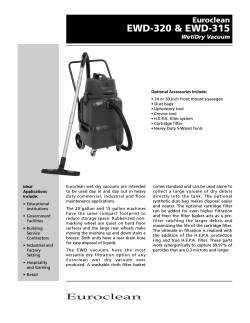
Document 272800
OFFSET WINDOWING FOR FIR FRACTIONAL-SAMPLE DELAY
G. D. Cain*, A. Yardim* and P. Henry+
*
University of Westminster, 115 New Cavendish St., London W1M 8JS, England
ESIEE Paris, Cite Descartes, BP 99,93162 Noisy le Grand Cedex, France
Email: yardim@cmsa.westminster.ac.uk
+
ABSTRACT
Non-optimal FIR filters used for fractional-sample
delay, despite their wideband nature, are shown to benefit
significantly from application of windowing. Here simple
raised-cosine windows prove to be very effective,
particularly if they are cast as asymmetric modifications
of their conventional forms. The offset von Hann
window is surprisingly potent when the number of
coefficients is large and window offset coincides with the
fractional delay required of the overall filter.
rapidly tuned to different delay values.
Several
closed-form expressions for obtaining filter coefficients
are in use, though their suboptimal nature partially
negates their implementation appeal. The objective of
this paper is to explore ways for improving the
performance of such simple fractional-sample delay filters
through the expedient of windowing.
We set out to approximate well the ideal desired
mnsfer function.
1. INTRODUCTION
where v is normalized frequency and
Fractional-sample delay is a topic of increasing
interest in various application sectors of digital signal
processing.
Symbol timing recovery [ 11, precision
beamforming and prediction in speech coding ~ I Ejust a
few of the areas where the ability to have controlled
offset of sampled signals is of great benefit. Although
multirate systems can in principle perform interpolation,
delay and subsequent re-decimation in order to gain
access to intra-sample data, their use is sometimes an
''overkill'' solution for dynamic situations like adaptive
delay estimation. Frequently the need is for a monorate
system that can perform selectable interpolation by means
of standard digital filters.
Growing interest has been shown in stand-alone
fractional delay subsystems (realized by both FTR and IIR
filters [2], [3]) as well as in filters which combine
fractional delay along with other functionality (e.g.
fractional-sample-delayed differentiation [41) thereby
promoting rendezvous goals concurrent with processing
tasks. While some excellent fractional delayors c,m be
delivered by powerful optimization algorithms, in
real-time data communication there is considerable need
for simple (usually small FIR) delayors which can be
0-7803-24314/95 $4.00 0 1995 IEEE
Here, for an FIR filter having N coefficients, a equals
(N-1)/2 as customarily seen in expositions of
linear-phase design. It is the added delay factor "r" that
offsets the filter impulse response centre of symmetry and
takes us out of the realm of linear-phase design in the
traditional sense. Indeed, due to restriction to only N
coefficients, there is no true impulse response symmetry,
even if (wastefully) r should happen to be an integer in
the range [-cl, a], since coefficients demanded for
symmetry "drop off one end". Our concern is with the
more subtle impulse response lopsidedness incurred when
r is non-integer. Restriction to r E [ - O S , 0.51 is of
principal interest, since bulk integer delays are readily
available to "take up the slack" in any overall delay
requirement.
Our task is to design a practical z-domain transfer
function H(z) such that the total error magnitude
1276
I E(V)I = I H(eJ * n v ) - D(v) I
(3
is kept acceptably small. Complete success (for arbitrary
r in our basic range) is easy at d.c. and impossible at
Nyquist frequency, where the Tarczynski Bound
I~(0.5)I 2 I sinpm I
(4)
must always apply [2], [3]. Thus we must take a
baseband-oriented view of approximation quality.
Full-band approximation fidelity is a pointless aspiration.
The delay filter sought will normally not have a cutoff
frequency in the sense that a lowpass filter does: we must
instead decree a measurement cutoff frequency. In our
work we have chosen to focus on two regimes when
assessing quality of a fractional delayor: d.c. up to v =
0.25 (which we call "halfband designs" occupying SO% of
the available band) and d.c. up to v = 0.45 ("wideband
designs" which handle 90% of the full band).
despite its widespread usage such a sinc filter performs
poorly in the fractional-sample delay role. Superior
performance is achievable with Frequency Sampling
designs, which come in four standard variants depending
upon the evenness or oddness of N and whether transfer
function samples are anchored at d.c. or at Nyquist
frequency. Such designs can be put in closed form, and
prove to be valuable altemative non-optimal candidates
for windowing. Our paper will be confined to just the
sinc filter (badly in need of improvement) and, for
brevity, only to odd values of filter size N. Our work in
[2] has shown that N odd will always be preferable to
even N when r E [-0.25, 0.251, so we have selected only
the specimen case r = 0.2 here to illustrate how windows
might be employed to make a favourable situation even
better.
Figure 1 shows what happens when wideband
measurements are made on a sinc filter before and after
multiplication by two raised-cosine windows:
2. WINDOWING SINC FRACTIONAL DELAYORS
The most popular way of practically implementing
fractional delay is by utilizing the SINC filter:
where k is the "time" index ranging between 0 and N-1
(inclusive) and h(k) is the impulse response sequence
corresponding to H(eJ 2 n v ) . We have shown in [2] that
when r, = 0 and C = 0.46, as it must be if the "classic"
linear-phase Hamming window is in use. We can also
clearly see the (low-frequency) benefit the von Hann
window (C = 0.5) imparts.
F S
Normalized Frequency
Figure 1 Effect of Hamming and von Hann Windowing on Wideband Error Profiles
(r = 0.2; r, = 0 N = 21: Tarczynski Bound = 0.588)
It is germane to wonder whether some departure
from the tmditional linear-phase window would be even
more successful. Different choices of r, in (6) turn out
to have little effect on wideb,and performance. However,
1277
as Figure 2 shows, the peak error (measured in dB) seen
in the halfband measurement frame is dramatically
reduced. The lower cluster of curves suggests that
optimal effect from this window is obtained when the
window offset is harmonized with the filter’s delay (that
is, r, = r). This choice eliminates the error bias evident
in Figure 1.
no window
--120
!
0
10
20
40
30
50
80
70
I
80
Number of Filter Coefficients (odd N only)
Figure 2 Halfband Comparison for Hamming Window Offset
(r = 0.2 and odd N Sinc Delayors)
Contrasting the two heavy solid traces in Figure 2, it
is obvious that this type of windowing is always worih
doing, and that as much as 50 dB enhancement margin is
obtained thereby for large N!
Results for several window types are given in Figure
3. Notice that wideband results are being shown, where
even the von Hann window can create an improvement
margin (over no windowing) of 20-30 dB for large N. It
is prudent to consider other aspects of error distributions
before becoming too enthusiastic about abatement only of
peak error; happily rms error also shows a similar
tendency, suggesting that the error characteristics, more
broadly, are amenable to
containment and potent
reduction through windowing.
01
Kaiser
10
20
50
40
50
EO
Number of Filter Coefficients (odd N only)
Figure 3 Wideband Comparison of Several Offset Window Types
( e r w=0.2; odd N Sinc Delayors)
1278
70
6
3. REMARKS
then, as exhibited in Figure 4, windowing shows its
worth. Notice the very rapid improvement as filter sizes
go above about 7. Again, von Hann performance for its
manifest simplicity is sumrisingly good!
Figure 3 indicates that windowing is not worth the
effort for filters below N = 19. However, this is a harsh
view; if halfbnnd judgements can instead be tolerated
Ol
-1204
0
10
20
40
30
50
60
Number of Filter Coefficients (odd N only)
70
$0
Figure 4 Halfband Comparison for the Same Conditions used in Figure 3
The small cross-section of results given here merely
shows the surface of the complicated tradeoff patterns
which characterize this method of FIR fractional-sample
design. Although it is not meaningful to make sweeping
pronouncements about relative merits of various window
schemes, we are at least able to say that, if error over
somewhat less than 90% of full band is of interest, then
windowing is nearly always attractive, and its potency
grows with filter size. Windowing can do much to make
the sinc filter more worthy of its popularity. Comparable
attractions are also found for Frequency Sampling
designs.
Acknowledgement: Our interest in the windowing
approach to this problem arose from valuable discussions
with Dr. Les Sabel of DSTO, Australia, who seems to be
one of the few investigators to have employed windowing
in a system which harnesses fractional delay [SI.
4. REFERENCES
[ l ] Erup, L., F. M. Gardner and R. A. Harris,
"Interpolation in digital modems - Part 11:
implementation and performance", IEEE Trans.
Comms., vol. 41, no. 6, pp. 998-1008, June 1993.
1279
Cain. G. D., N. P. Murphy and A. Tarczynski,
"Evaluation
of
several
variable
FIR
fractional-sample delay filters", Proc. ICASSP
94, Adelaide, Australia, vol. 3, pp. 621-624,
19-22 April 1994.
Tarczynski, A. and G. D. Cain, "Design of IIR
fractional-sample delay filters", presented at
Second Int'l Symposium on DSP for
Communication Systems, SPRI, Adelaide, 26-29
April 1994.
Hermanowicz, E. and M. Rojewski, "Design of
FIR first order digital differentiators of variable
fractional sample delay using maximally flat
error criterion", Electronics Letters, vol. 30, no.
1, pp. 17-18, 6 Janunry 1994.
Sabel, L. P. and W. G. Cowley, "A recursive
algorithm for the estimation of symbol timing in
PSK burst modems", Proc. Globecom 92,
Orlando, vol. 1, pp. 360-364, 6-9 December
1992.
© Copyright 2025












